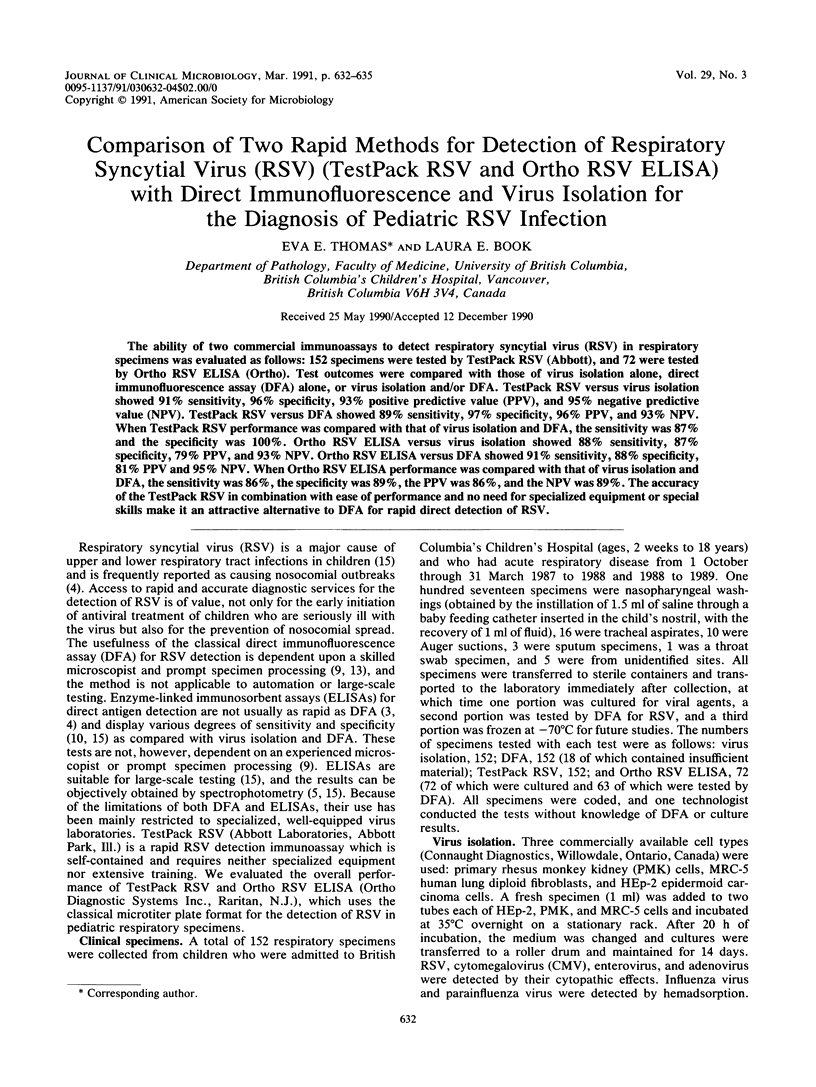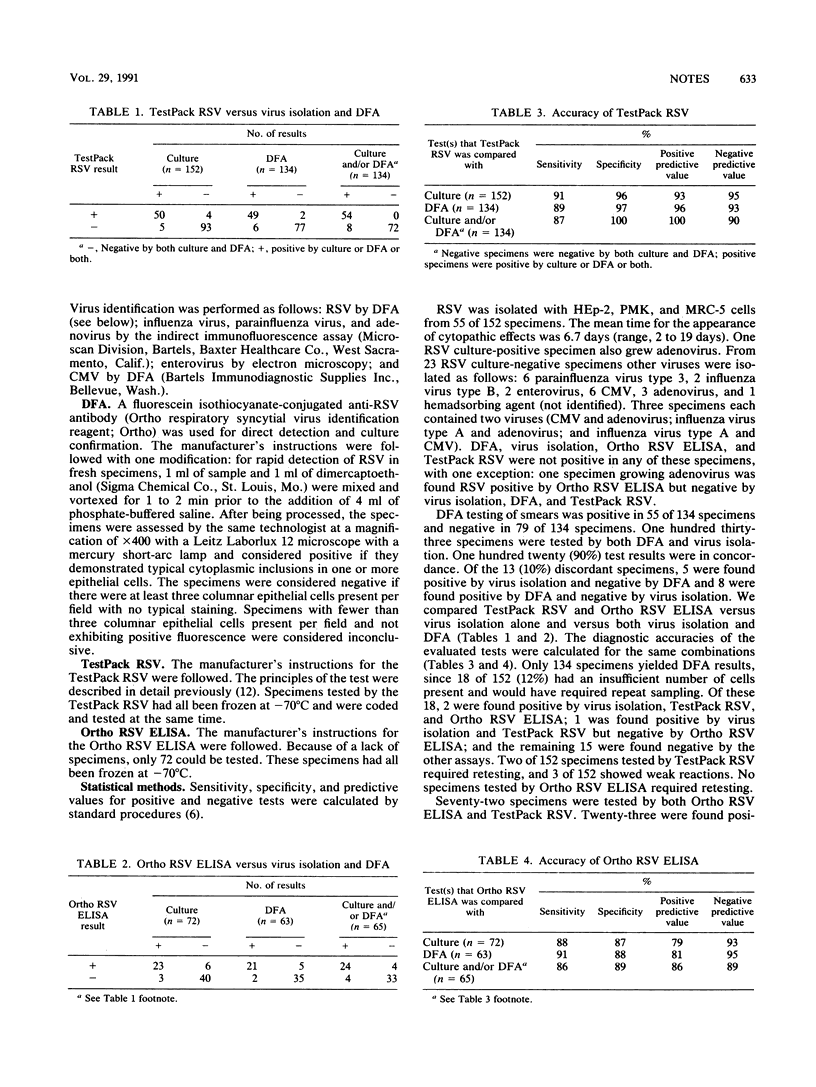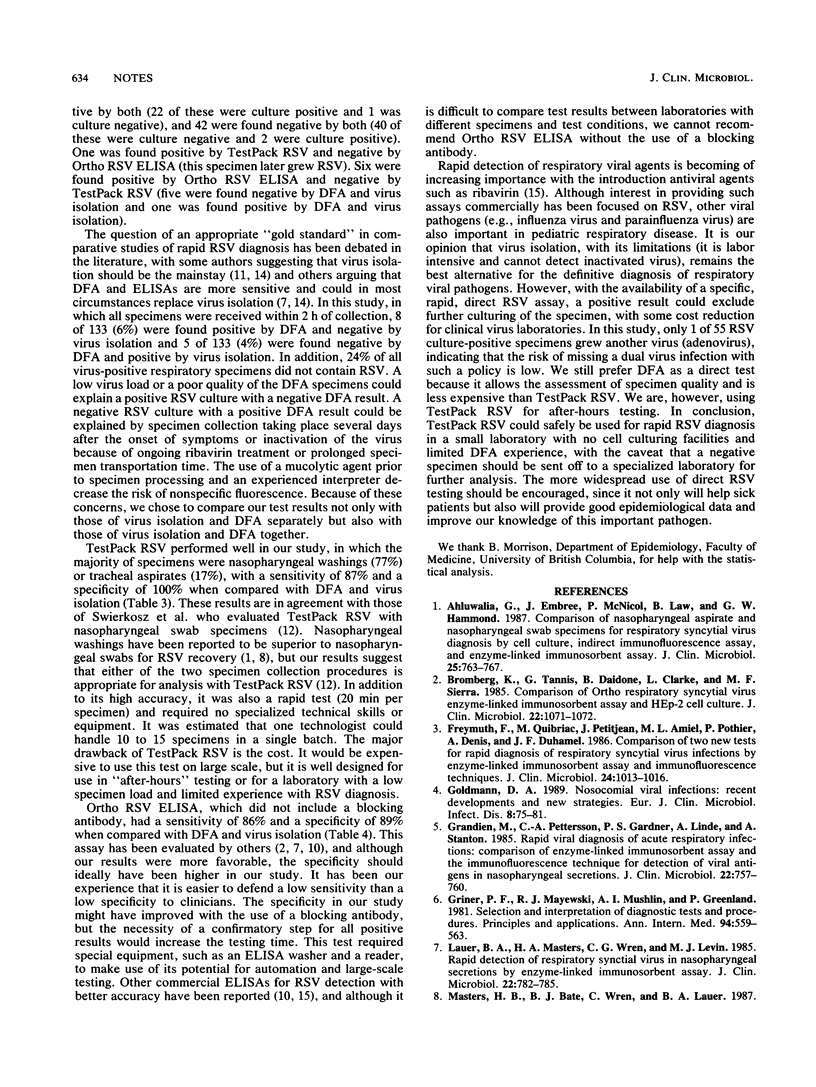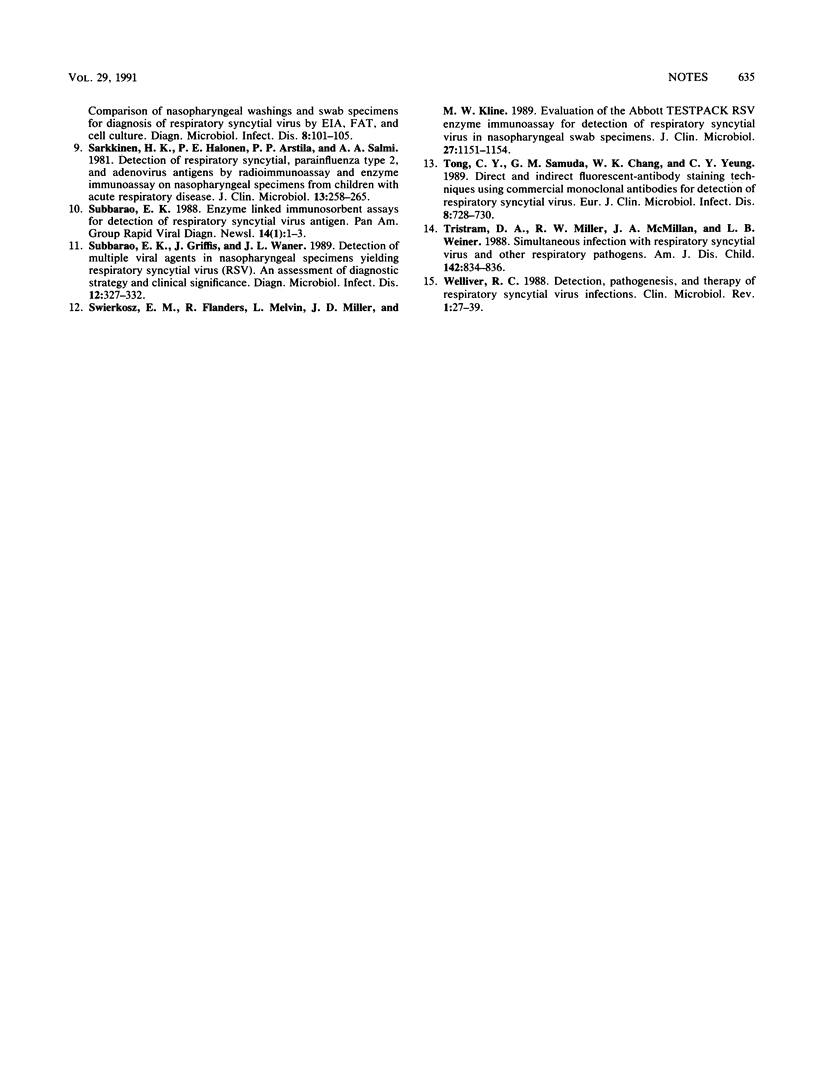Abstract
The ability of two commercial immunoassays to detect respiratory syncytial virus (RSV) in respiratory specimens was evaluated as follows: 152 specimens were tested by TestPack RSV (Abbott), and 72 were tested by Ortho RSV ELISA (Ortho). Test outcomes were compared with those of virus isolation alone, direct immunofluorescence assay (DFA) alone, or virus isolation and/or DFA. TestPack RSV versus virus isolation showed 91% sensitivity, 96% specificity, 93% positive predictive value (PPV), and 95% negative predictive value (NPV). TestPack RSV versus DFA showed 89% sensitivity, 97% specificity, 96% PPV, and 93% NPV. When TestPack RSV performance was compared with that of virus isolation and DFA, the sensitivity was 87% and the specificity was 100%. Ortho RSV ELISA versus virus isolation showed 88% sensitivity, 87% specificity, 79% PPV, and 93% NPV. Ortho RSV ELISA versus DFA showed 91% sensitivity, 88% specificity, 81% PPV and 95% NPV. When Ortho RSV ELISA performance was compared with that of virus isolation and DFA, the sensitivity was 86%, the specificity was 89%, the PPV was 86%, and the NPV was 89%. The accuracy of the TestPack RSV in combination with ease of performance and no need for specialized equipment or special skills make it an attractive alternative to DFA for rapid direct detection of RSV.
Full text
PDF



Selected References
These references are in PubMed. This may not be the complete list of references from this article.
- Ahluwalia G., Embree J., McNicol P., Law B., Hammond G. W. Comparison of nasopharyngeal aspirate and nasopharyngeal swab specimens for respiratory syncytial virus diagnosis by cell culture, indirect immunofluorescence assay, and enzyme-linked immunosorbent assay. J Clin Microbiol. 1987 May;25(5):763–767. doi: 10.1128/jcm.25.5.763-767.1987. [DOI] [PMC free article] [PubMed] [Google Scholar]
- Bromberg K., Tannis G., Daidone B., Clarke L., Sierra M. F. Comparison of ortho respiratory syncytial virus enzyme-linked immunosorbent assay and HEp-2 cell culture. J Clin Microbiol. 1985 Dec;22(6):1071–1072. doi: 10.1128/jcm.22.6.1071-1072.1985. [DOI] [PMC free article] [PubMed] [Google Scholar]
- Freymuth F., Quibriac M., Petitjean J., Amiel M. L., Pothier P., Denis A., Duhamel J. F. Comparison of two new tests for rapid diagnosis of respiratory syncytial virus infections by enzyme-linked immunosorbent assay and immunofluorescence techniques. J Clin Microbiol. 1986 Dec;24(6):1013–1016. doi: 10.1128/jcm.24.6.1013-1016.1986. [DOI] [PMC free article] [PubMed] [Google Scholar]
- Goldmann D. A. Nosocomial viral infections: recent developments and new strategies. Eur J Clin Microbiol Infect Dis. 1989 Jan;8(1):75–81. doi: 10.1007/BF01964124. [DOI] [PubMed] [Google Scholar]
- Grandien M., Pettersson C. A., Gardner P. S., Linde A., Stanton A. Rapid viral diagnosis of acute respiratory infections: comparison of enzyme-linked immunosorbent assay and the immunofluorescence technique for detection of viral antigens in nasopharyngeal secretions. J Clin Microbiol. 1985 Nov;22(5):757–760. doi: 10.1128/jcm.22.5.757-760.1985. [DOI] [PMC free article] [PubMed] [Google Scholar]
- Lauer B. A., Masters H. A., Wren C. G., Levin M. J. Rapid detection of respiratory syncytial virus in nasopharyngeal secretions by enzyme-linked immunosorbent assay. J Clin Microbiol. 1985 Nov;22(5):782–785. doi: 10.1128/jcm.22.5.782-785.1985. [DOI] [PMC free article] [PubMed] [Google Scholar]
- Masters H. B., Weber K. O., Groothuis J. R., Wren C. G., Lauer B. A. Comparison of nasopharyngeal washings and swab specimens for diagnosis of respiratory syncytial virus by EIA, FAT, and cell culture. Diagn Microbiol Infect Dis. 1987 Oct;8(2):101–105. doi: 10.1016/0732-8893(87)90156-8. [DOI] [PubMed] [Google Scholar]
- Sarkkinen H. K., Halonen P. E., Arstila P. P., Salmi A. A. Detection of respiratory syncytial, parainfluenza type 2, and adenovirus antigens by radioimmunoassay and enzyme immunoassay on nasopharyngeal specimens from children with acute respiratory disease. J Clin Microbiol. 1981 Feb;13(2):258–265. doi: 10.1128/jcm.13.2.258-265.1981. [DOI] [PMC free article] [PubMed] [Google Scholar]
- Subbarao E. K., Griffis J., Waner J. L. Detection of multiple viral agents in nasopharyngeal specimens yielding respiratory syncytial virus (RSV). An assessment of diagnostic strategy and clinical significance. Diagn Microbiol Infect Dis. 1989 Jul-Aug;12(4):327–332. doi: 10.1016/0732-8893(89)90098-9. [DOI] [PubMed] [Google Scholar]
- Swierkosz E. M., Flanders R., Melvin L., Miller J. D., Kline M. W. Evaluation of the Abbott TESTPACK RSV enzyme immunoassay for detection of respiratory syncytial virus in nasopharyngeal swab specimens. J Clin Microbiol. 1989 Jun;27(6):1151–1154. doi: 10.1128/jcm.27.6.1151-1154.1989. [DOI] [PMC free article] [PubMed] [Google Scholar]
- Tong C. Y., Samuda G. M., Chang W. K., Yeung C. Y. Direct and indirect fluorescent-antibody staining techniques using commercial monoclonal antibodies for detection of respiratory syncytial virus. Eur J Clin Microbiol Infect Dis. 1989 Aug;8(8):728–730. doi: 10.1007/BF01963762. [DOI] [PubMed] [Google Scholar]
- Tristram D. A., Miller R. W., McMillan J. A., Weiner L. B. Simultaneous infection with respiratory syncytial virus and other respiratory pathogens. Am J Dis Child. 1988 Aug;142(8):834–836. doi: 10.1001/archpedi.1988.02150080040017. [DOI] [PubMed] [Google Scholar]
- Welliver R. C. Detection, pathogenesis, and therapy of respiratory syncytial virus infections. Clin Microbiol Rev. 1988 Jan;1(1):27–39. doi: 10.1128/cmr.1.1.27. [DOI] [PMC free article] [PubMed] [Google Scholar]


